Hours: Thurs-Mon, noon-6 pm

Enrichment is an important element in caring for cats, especially in the often-stressful shelter environment. CCS has always had a dedicated team of volunteer socializers and animal care technicians to support cats. But when two current staff members started, they saw an opportunity to increase the impact.
One animal care tech took an interest in feline enrichment and laid the groundwork. Kelly Cunningham, now our lead enrichment specialist, created an “enrichment calendar” to use with the cats. However, with few supplies, she had to get creative, collecting paper towel rolls, crinkly paper and pipe cleaners to provide enrichment on a shoestring budget.
Once Sonia Holmstrom, CCS’ foster & behavior supervisor, joined the team last year, things took off. With a background in animal behavior and experience in zoos, she has been hard at work creating our own behavior & enrichment program. Thanks to our recent partnership, we’ve implemented KONG’s toys in the shelter to create specialized enrichment experiences for the cats.
“Since the enrichment program found funding, we were able to get more supplies, treats and toys to stock the shelf,” Kelly shared. “The kitties are spoiled with the coolest and newest cat toys on the market! Everything we use for enrichment now benefits the cats by allowing them to feel safe, comfortable and confident enough to express their natural behaviors. We’ve already seen such an improvement in the overall happiness of our cats.”
“It has been fun to build a program that targets improved mental stimulation, exercise and socialization for cats in the shelter, as well as for adopted cats,” Sonia said. “We want to see cats expressing their natural behaviors while also strengthening a bond with humans. The enrichment program has also supported our efforts with cats who need behavior modification.”
“Our shy kitties come around at a much quicker pace than before,” Kelly added. “Many of the anxious and fearful cats come out of their shell faster, and it’s because we have a dedicated team of staff and volunteers who make sure these cats are enriched and happy. Before the program, it would take some cats months to show any behavioral improvement. Now, most of them improve in weeks! This can drastically reduce the length of time they spend in the shelter. Confident cats are adoptable cats!”
What’s the difference? Cat enrichment enhances overall well-being, while behavior modification targets specific behaviors for improvement.
A cat’s enrichment is tailored to their needs based on factors like age, diet, medical needs, behavior and personal preference. A successful tailored enrichment program provides:
“First, I consider the environmental enrichment,” Kelly said. “The rooms are set up to fit the individual needs of the cats to reduce stress and anxiety: Where do they like to hang out? Do they like vertical space? Do they prefer to have their own ‘corner’? In a multi-cat room, this is accomplished by splitting the room into smaller areas, each spot with its own bed, food/water and litter box so each cat can claim their own space and reduce tension over territory. The furniture is strategically placed to maximize the ‘cat superhighway’ space and allow for more vertical movement. I also consider what kind of bedding they prefer, if they sleep up high or down low, if they hide/play in tunnels or use them to cross the room unseen. Many cats prefer water fountains, which are great for environmental enrichment. A variety of scratchers are also a necessity for scent-marking. I make sure to include several different kinds of toys; I put battable toys of different textures, (crinkly, soft, jingle bell) on the floor and on high surfaces. I also set out solo play toys, such as the ball & track type or interactive/motion toys. Finally, I leave out treat puzzles for cognitive stimulation. Before I leave the room, I engage in hunt and play sessions with the kitties. Our enrichment charts have a spot for comments where we write the cat’s preferences or favorite toys, which has been helpful in deciding what to use each day.”
Kelly’s favorite recent success story is Holly and Chloe, a pair who came to CCS extremely fearful and reactive. Because of their age and some medical issues, at first we did not believe they would have a successful outcome. Kelly began to visit them several times a day, playing David Teie’s cat frequency music while sitting on the floor, offering a Churu treat and some calming words and pets with a telescoping brush.
“Chloe seemed to be a bit more social and less reactive than Holly, but I was still determined to help these two feel safe and happy,” she explained. “Holly moved into her own room and relaxed only a tiny bit, so she went to a lovely behavior foster who put in so much time and effort helping her come out of her shell. Truly, Holly’s behavior would not have improved without the help of our foster. In the meantime, Chloe was moved into the shy cat room. I visited her several times a day and gave her lots of treats and attention. For a while she would remain in the hidey cube and let me pet/talk to her, but after two weeks, she would come out of the cube to greet me and solicit pets. Then I began short play sessions and offered treat puzzles (which I discovered she absolutely loved). A month or so later, Chloe had improved remarkably and was greeting most people who entered the room and showed her some attention. Holly came back from foster and joined her sibling in the room. I used the same methods on Holly then; consistently going in to sit with her, establish trust and build confidence. About a week before she got adopted, she was also coming out of the hidey bed to greet me when I approached. I truly believe these two became so confident and happy because of the dedication of our love, attention, time and enrichment we provided for them during their stay. I’m so happy they both found their forever homes. I’m so proud of how far they came!”
There can be misconceptions about what enrichment for cats. Though cats can be independent or aloof, that doesn’t mean they don’t need interaction. “Enrichment is necessary for the physical and emotional well-being of cats, which is more than just playing with them,” Kelly said. “Enrichment provides an environment that is comfortable, safe and stimulating. Enrichment gives cats the confidence to be their best selves. Imagine if you lived in a house with nothing to entertain you or make you feel at home! No comfy beds or couches, no TV, no video games, no snacks or hobbies. Life would be pretty boring. Cats are no different, and it’s our responsibility as pet owners to give our animals a fulfilling, happy life.”
To learn more, visit our Behavior & Enrichment program page!
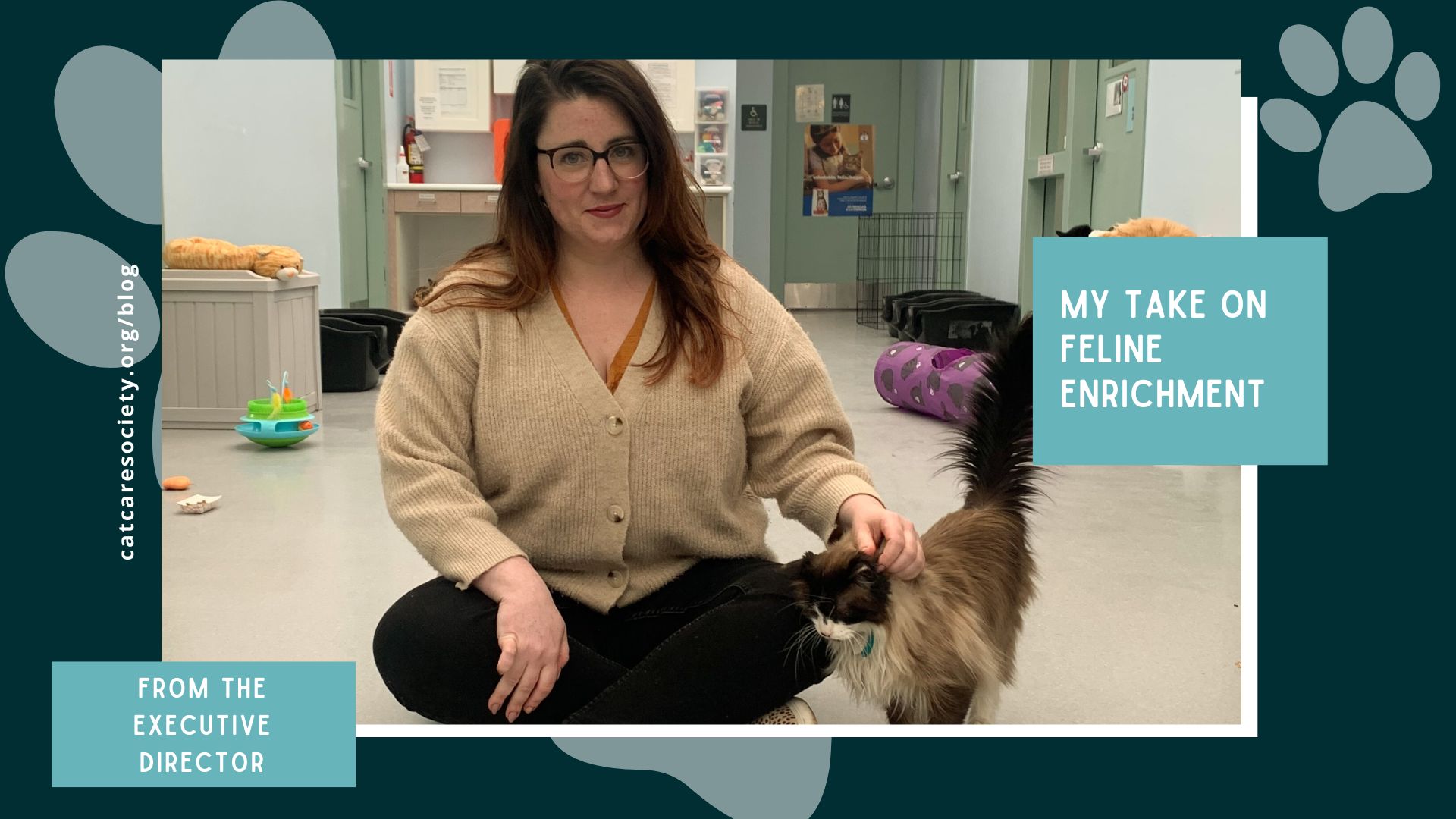
It’s another busy summer season here at Cat Care Society. As is typical for this time of year, we are seeing a rise in requests to take in cats as we — and many other shelters — navigate the influx of kittens. As we head toward the final peak of the season around October, we also have several irons in the fire for CCS’ future. You may have noticed some construction recently as we install a new elevator. More special projects are in the works to ensure our building can best serve the cats in our care.
In our summer 2024 Cat Care Quarterly, you will find several articles about cat behavior and enrichment — two topics that we’ve been focusing on lately that you will hear more about! It’s so important to us to offer experiences that help build the minds and bodies of our feline friends so that they are happier, healthier and more adoptable.
But there are actually some common misconceptions about why exactly enrichment matters. In fact, research about cats has been significantly behind what has been done for behavior modification in dogs. Why is this? While there is a long and varied list that has brought about this lag, much of it is related to the idea that cats are more independent and not as social as dogs.
Posing a potential risk to the public, animal welfare policy has been directed at statutes focusing on dogs as well as the creation of animal shelters to house them. This focus is partially why they’ve received the bulk of behavioral research! Unfortunately for cats, they haven’t received the same level of support until recent years.
Throughout my time working in shelters, I’ve seen a few trends play out. Dog owners experiencing unwanted behaviors often think about working with a professional to resolve an issue. Plus, it’s easier to find a dog trainer than a cat behaviorist. Cat owners are more likely to view a problem as unfixable (or too hard to fix) and rehome or surrender them.
Some shelters don’t take in cats in the first place, and even more aren’t able to offer formalized enrichment to the cats in their care due to capacity. The flip side of this is that cats are more at risk for health issues in shelters because they don’t handle stress well. Additionally, behavior exhibited by cats is often labeled incorrectly, limiting our ability to create possible interventions and support plans.
That’s what we’re trying to change. By building a comprehensive cat enrichment and behavior program, we hope to begin slowly changing the narrative and evening out these trends. Cat Care Society has long been dedicated to supporting cats and their owners through adopter education and seminars. But now, we’re ready to take it a step further. We want to up our game and offer better avenues for cats in our care to exhibit normal behaviors. The opportunity to learn to trust humans, to play with toys, stimulate their senses and increase their physical and mental development, is something we are so passionate about and excited for.
When we take in unsocialized or fearful cats, we’ll now have a system for them to gain confidence faster, to address their needs in meaningful ways and create opportunities for those who have a need that has gone unfilled.
We couldn’t do this work without the support of our partners, though. We are so thankful for the other shelters in our area who trust us to take in their animals and work with them successfully. Because other rescue groups — especially those in rural areas — don’t have the same resources, we welcome their animals to our facility to work with our medical and behavioral team and have a real chance.
We have seen countless animals who weren’t thriving in other shelters or a prior home come out of their shells and completely transform once they’re in an environment that offers them the space and support to blossom. No shelter is the same as a home, but the closer we can get to that, the better a cat will do. Our free-roaming spaces and enrichment opportunities means that these kitties can become their true selves, find their natural behaviors and let their personalities shine. This makes adopters be able to envision that cat in their home easier and have a more successful adoption story. And every adoption — and foster home — means that we are able to help one more cat have that same opportunity.
If you’re looking for more information on cat enrichment or need help finding a behaviorist, please visit our website’s Resources, Enrichment and Blog pages, or reach out to talk to us about how we can help!
More Resources

A woman full of life, love and light, another Cat Care Society supporter, Leanne Emm passed away this past March.
A fourth generation Colorado native, Leanne was known for her sense of adventure, intellect and devotion. With decades of public service, she held roles in city and county government, going on to lead as the deputy commissioner of the Colorado Department of Education. When she wasn’t working, Leanne loved fitness, river rafting, watercolor paintings and napping in the sun with her cats (four of them adopted from CCS!).
Leanne served on CCS’ board of directors in 2017, and after retiring from her career in 2018, stepped into a larger, critical role as interim executive director. “It had been a turbulent couple of years for CCS, and Leanne was such a positive, steadying influence,” remembers Clyde Dawson, another long-time board member. “And what a sense of humor! As it turned out, one of the most important contributions she made to CCS was organizing and conducting the search for a permanent ED. She was an avid whitewater rafter and had been looking forward to river-running nearly full time in retirement. She also remained a strong supporter of the organization.”
Clyde recalls Leanne as a tremendous asset to CCS — “exceptionally intelligent, with a keen grasp of finances and management issues of all sorts, as well as warm and engaging,” he said. “I think she won us all over when she wrote in her board application that one reason she was interested in board service was that it would give her an excuse to come into the shelter more often and play with the cats!”
Leanne’s daughter Charlotte says that her mother loved cats her whole life, that they were a really grounding thing for her. “She just loved all animals, and cats were her favorites — that and baby goats and horses!” she said. “She loved CCS and seeing how happy people were when they got to bring a cat home.”
Leanne’s last update in the summer 2018 Cat Care Quarterly oozed her warm, bright personality and gratitude. For everything that she brought to our organization and the world, we’re grateful for her, too.

A long-time Cat Care Society supporter and leader, Gail Tinianow, passed away this spring, leaving behind a commitment to cats and a love for travel.
A child of Air Force parents, Gail was born in New York and lived in various parts of the U.S. and Spain. Early in her career, Gail worked for the federal government in Washington, D.C., and eventually earned a degree in business administration from Arapahoe Community College. She and her husband Marty married in 1985; she retired in 2006. Marty shared that Gail’s love of cats was extensive.
Her retirement marked the start of a 10-year dedication to Cat Care Society, when she began looking for volunteer opportunities. Jane Dorsey interviewed Gail to work in Cajun’s Closet, Cat Care’s thrift shop, in 2008. In 2011, she joined the board of directors to help ensure the financial success of CCS. Over the next several years, she would go on to hold roles of secretary, vice president, and president. In those days, CCS had a working board, recalled Ken Dobrovolny, so Gail was hands-on in the day-to-day operations of the shelter “and ran a tight ship.”
Jane Dorsey recalls Gail’s enjoyment of the Santa Paws Festival and the role she played in the planning committee. “I remember her bringing detailed records of everything from the prior year and challenged us to make it even better,” she said. “She was so enthusiastic about everything she took on, and that made it fun to work with her.”
Gail also generously donated a trip to her timeshare in Hawaii for the Tails of the Painted Cats auction more than once. “She was so excited when she came up with the idea of pairing a trip with a Hawaiian-themed sculpture,” Jane said. “Artist and volunteer Pat Lickly created the Hawaiian cat, and we had fresh flower leis made for Gail and the high bidder that night. She loved that event and whole-heartedly supported it.”
In the winter 2016 Cat Care Quarterly as board president, Gail wrote: “Our first order of business in the new year entails recruitment of an executive director. Your board has been running the Society since 2011, and I’m happy to report that we are now financially strong enough to fill this position. I’m simply honored to be at the helm of this great organization and cannot express enough appreciation for our amazing donors, volunteers and staff.”
Gail eventually stepped back from the board in 2018, but we will remember her for many, many more years to come.

Two vet team members pose with Rambo, a CCS cat who recently received leg braces
It’s hard to say who is most valuable to an organization, but for a cat shelter, the medical and veterinary team is absolutely crucial in keeping our animals healthy. Here at Cat Care Society, a small handful of employees are responsible for the overall well-being of the cats and caring for any medical issues that come through the doors.
Many people may not realize that the vet team in a shelter looks very different than a traditional private vet clinic. This is because not only do they treat any current medical needs an animal has, but they’re also responsible for considering the medical pathway for a cat all the way through adoption. This dynamic team treats animals not just in our shelter, but readies them for life in a home setting. And, they have to balance this work in a noisy setting with multiple animals and people coming in and out, often with unexpected challenges to pivot around.
“The medical team in a shelter is a highly skilled team that we couldn’t do without,” said EC Michaels, CCS’ executive director. “They are asked to be on their feet while thinking big about the whole animal. When we get a cat with kidney disease, for example, they’re not just saying ‘they have kidney disease,’ but also looking at what we do to manage it here and how to educate adopters so they can manage it later. We are able to decrease the spread of contagion and increase adoptions because of this way of thinking.”
This team must also be ultra-coordinated because of the high volume of care that is needed, everyone has a role to play. The veterinary services manager oversees the whole process by scheduling the team, organizing surgical days, monitoring the shelter population, maintaining SOPs and protocols, monitoring inventory, and exploring new treatments. Our vet techs ensure the flow of animals that need treatment or surgery, run anesthesia, prioritize needs, check medications, maintain records, approve animals for adoption, and work with the foster team to build a plan for each cat. On surgery days, they ensure there is always a patient ready for a vet and administer drug protocols while the assistants monitor vitals, check diagnostics, sanitize tools and ensure the cats wake up appropriately.
Our veterinarians are able to perform about 30 spays and neuters in just one day! This happens about three times a month in the busy season and twice in the slower winter. They also do about 4.5 dental procedures a week — or 200 a year.
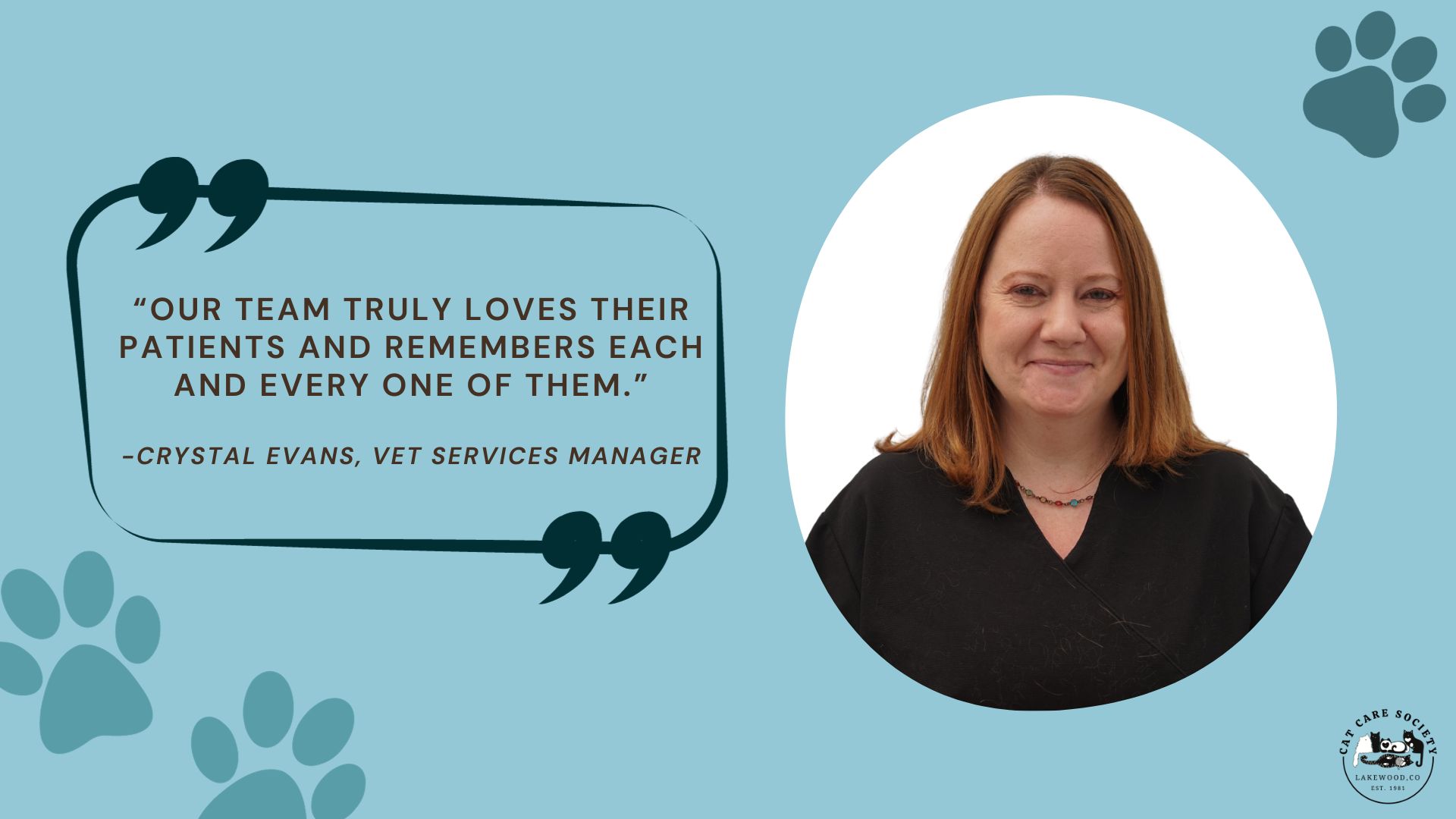
The medical team begins each morning by taking blood glucoses on the diabetic cats and feeding them breakfast, then providing treatments for the rest of the shelter. Then they either have scheduled surgeries, work through the CVT checklist or complete intakes on new cats. After this, they clean up the clinic and get ready for evening treatments, which includes another blood glucose reading and dinner for the diabetics, and medications for cats in the rest of the shelter.
On a daily basis, the medical team is constantly performing phlebotomy to obtain lab work, performing radiographs, running anesthesia for procedures, performing dental prophylaxis under the supervision of a veterinarian, performing intake exams on new cats arriving at the shelter, and making sure that our population is healthy and thriving. And of course, responding to any emergencies!
Another misconception is that every single animal in a shelter receives a full medical exam from a veterinarian. Because our shelter vets time is so limited, we preserve the resources we have. Therefore, only cats that require their attention are escalated to a vet by the rest of the team. Our techs are responsible for intake exams, which includes a general once-over and any vaccines and dewormers. Then, they are trusted to route the animal to either the adoption floor, for behavioral attention or to receive additional vet care.
We are also proud to take on some pretty complicated medical cases that weren’t previously managed for a cat before he or she came to our shelter. We’re often able to identify the source of a cat’s medical or behavioral issue and provide medication or treatment to improve their quality of life. It’s kind of like a medical makeover or a glow up so that they leave the shelter in better shape than when they came in. A recent example of this is Rambo (pictured above), who came to us early this year with three housemates after his owner passed away. After his initial exams and bloodwork, we noticed some lameness and within a few days, a limp was isolated to his left hind leg. Rambo was discovered to be walking flat on his entire foot rather than just on his toes. We also discovered pancreatitis and early stage kidney disease. He was switched him to a new diet, which helped Rambo’s daily life. After a few months, Rambo was fitted for a leg brace thanks to the help from an orthopedic specialist. He now has increased mobility and comfort to walk around thanks to his new brace!
“Our team truly loves their patients and remembers each and every one of them,” Crystal Evans, vet services manager, said. “We provide cats with a turbulent past or medical issue that would normally not be adopted out a second chance at finding their forever homes.”
Not only is this team advocates for the voiceless, but they ensure our cats are receiving the best care possible.
In calendar-year 2023, the CCS medical team was responsible for:
As of spring 2024, the CCS medical team consists of:
We thank each of them for their dedication, skills and contribution to the livelihood of our cats.
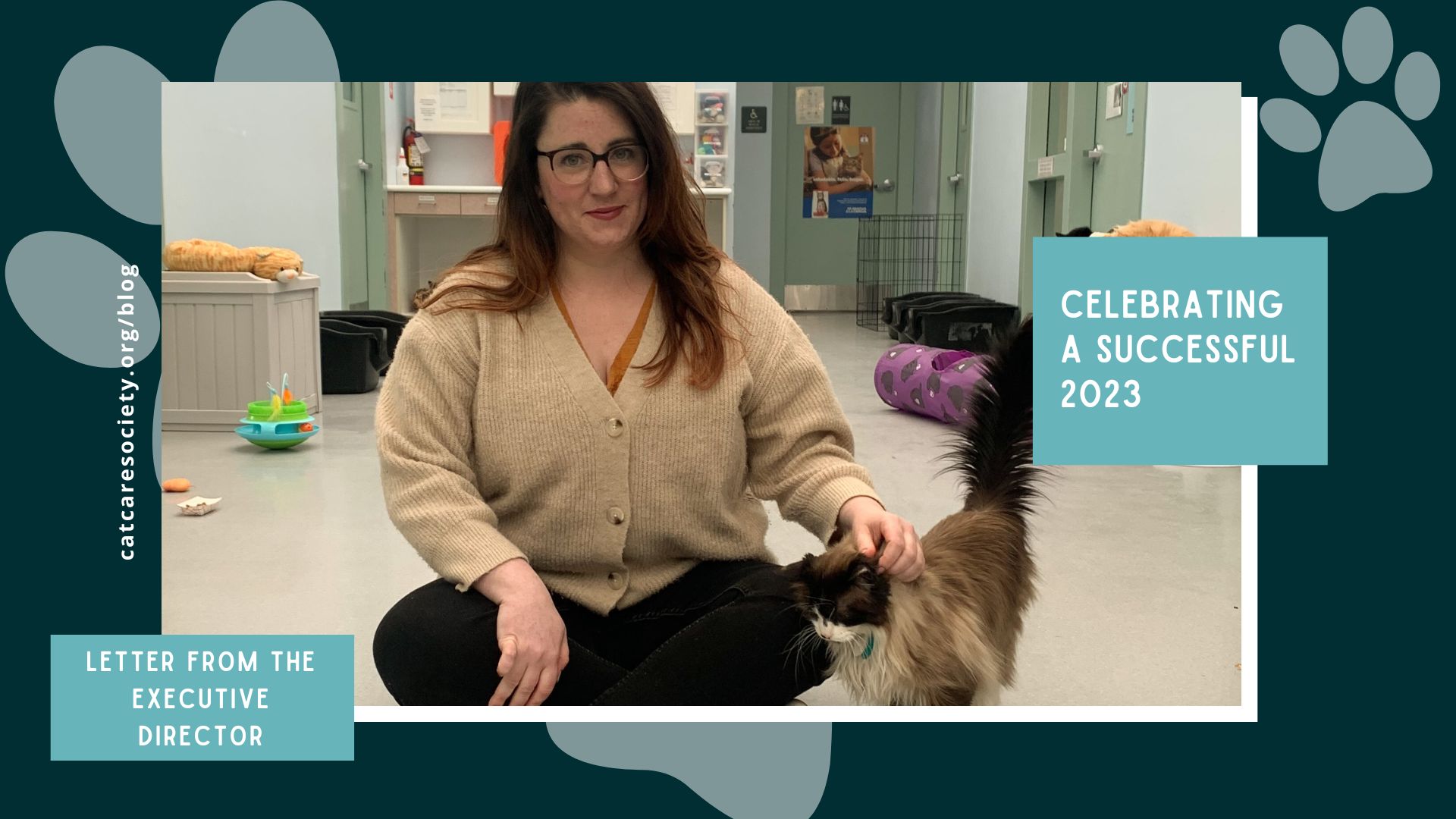
Now that 2023 is in our rearview, I am so humbled and excited to share our calendar-year stats and successes with you all. It was a busy year, with numbers up across the board. Even though we saw more cats in need than ever before, we also adopted more cats than ever before. Last year, over 1,000 cats were placed into loving homes thanks to your support!
In comparison, in 2022, Cat Care Society took in 860 cats and adopted out 750 of them.
Across the country, many shelters faced an increase in animals in need and owner surrenders. Economic conditions, inflation, lack of veterinary care and access, and the veterinary shortage, all affected the tough year that many shelters, rescues and animal welfare organizations faced.
I think it’s important to acknowledge that our statistics do not reflect the larger trend in animal welfare. It’s likely our specialty that makes us an anomaly. Because we care for so many special needs cats, our status as a limited-admission shelter, and our policies and partnerships, we recognize how special it was to help more cats find homes than we’ve ever been able to before. We also want to give a nod to the other shelters in our region, who work just as hard as we do to save and adopt as many pets as possible. We were happy to support their work by increasing the number of transfers we took in from our local shelter partners.
Over the last year or so, we’ve shifted how we think about taking in new cats. It’s easy to focus on the numbers above, but it’s just as important to think about the why behind them. For us, it’s all about balance for the entire shelter ecosystem.
This balance has helped us increase our support of special needs cats — as demonstrated by having over 100 diagnosable conditions we treat and place for — but we also know that CCS is more than that. No matter our niche, we will always support all cats in need. That includes young and healthy cats. Or cats who simply haven’t found a home in another shelter.
We’re proud to be members of the Metro Denver Animal Welfare Alliance (MDAWA) and work with many other organizations in the region to transfer cats in so they have a new opportunity here. We also aim to offer education for adopters on how to care for their cats.
Through it all, we balance our cat population against our resources; our staff size and budget must support our ability to care for the cats in our shelter. We’re constantly evaluating how we can grow proportionately. This is, after all, also aligned with our new strategic plan and CCS’ mission.
This level of control is one of the benefits of being a limited-admission shelter. By contrast, open-admission shelters are required to take in any animal that comes through their doors. If they happen to have an influx of complex medical cases (which require more time, money and expertise) at one time, they do not have the same options we do. It requires creative solutions — as well as some strain — on how they make it work.
Having worked in both types of shelters, I am so grateful for the unique community that Cat Care Society has. In my time here, I’ve challenged the team to be thoughtful and strategic in everything we do. Remaining a safe place for cats who need help, and finding them loving homes, is always our top priority.
I am more energized than ever to see what the rest of this year brings. As always, thank you for your support!
EC Michaels
Executive Director
Cat Care Society
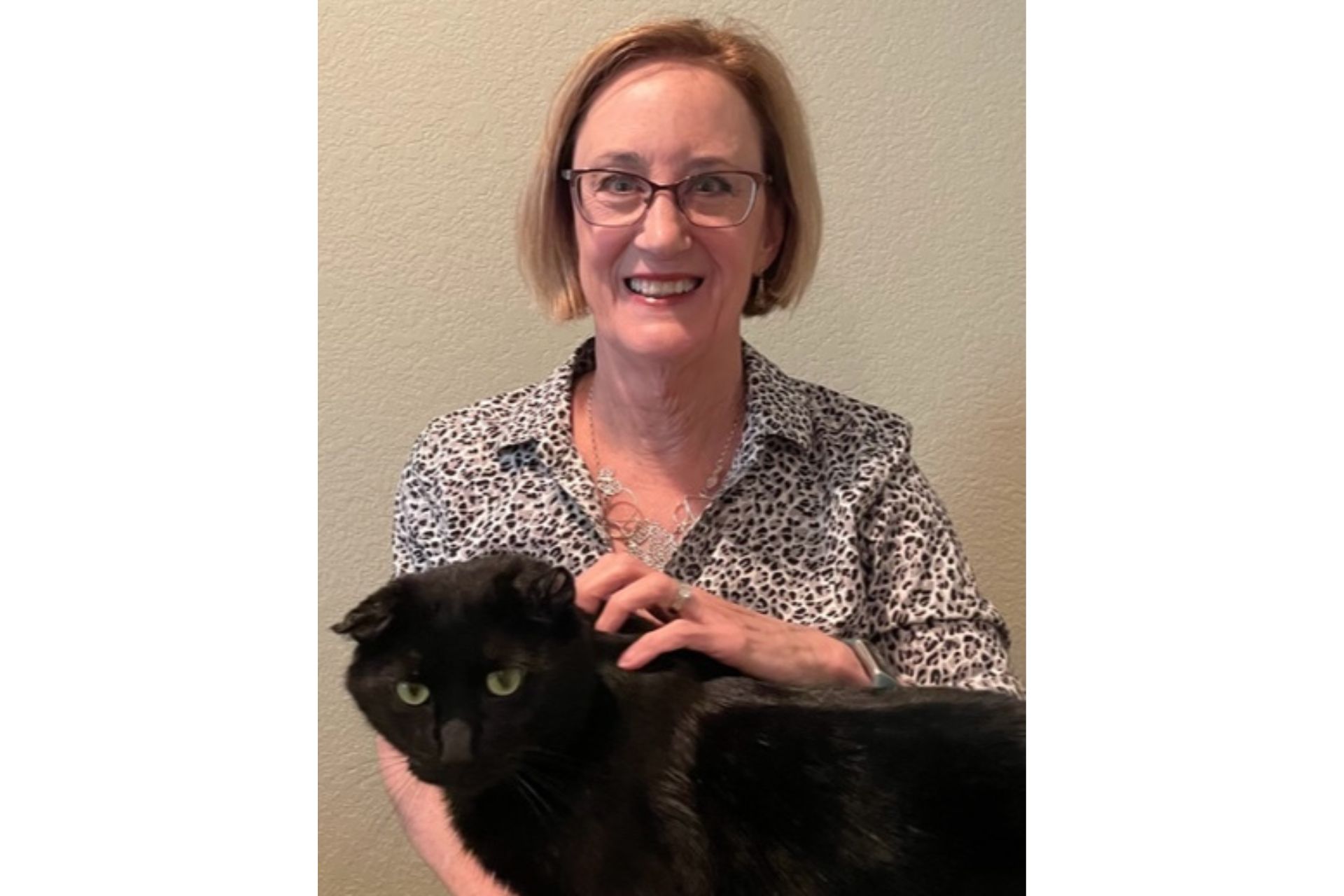
Kathy McChesney doesn’t do anything lightly. This Cat Care Society supporter extraordinaire goes the extra mile by serving on the board of directors and multiple committees, volunteering her time and resources, helping at events and providing transportation, and donating on top of it all. Why does she go so “all in” for CCS? “Because everything is about the cats!” she proudly exclaims.
Originally from Texas, Kathy moved to Denver in 2018 after years of running her own cat rescue. Relocating for work as an airline pilot, she retired in 2021. With her own passion for cats, she was on the hunt for a new cat shelter to help. Thanks to the suggestion of her financial advisor, Michaela Sullivan (who also now serves on the CCS board), she began donating to us. The real turning point was when she was invited to a holiday event and met some of the staff and saw the shelter in person.
Shortly after, Kathy joined the board and became even more involved. Today, she serves as secretary, is on the governance committee and strategic plan workgroup, assists at events, transports cats to specialty medical appointments, writes for our blog, donates financially through a donor-advised fund (DAF), and is a member of the Nine Lives Legacy Society.
Kathy has multiple cats of her own — all sweet rescues and strays that she has adopted who follow her everywhere — and is shining example of what a cat lover who gives back can look like. Kathy often brings her experience and perspective to the table, advocating for black cats and sharing how unique and special the animal welfare landscape is in Colorado. For instance, she shares that in Texas, shelters in the state are overwhelmed in a way that we haven’t quite seen here. Attitudes are cultures are different there, where it is more prevalent for animals to not be spayed or neutered, and sadly, often dumped if they’re no longer wanted. This is what fuels her to give back now.
“I donate because I’ve run own rescue and know how hard it is to get people to give; I understand the need,” she said. “Cats are the most important thing in my life, and I‘ve been fortunate in my career, so I’d rather help cats than anything else.”
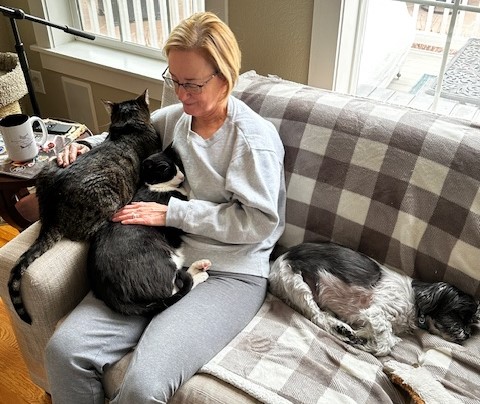
The reason Kathy keeps coming back to Cat Care Society in particular, she says, is because of the cats themselves and our policies. “It’s just everything, the open concept, the way we take in animals that would be put down somewhere else, the Temporary Care Program and how it helps people, and that we always go the extra mile for every single cat,” she said. “I’ve never seen a shelter that does that. It is so unique, and the cats are so happy. I can feel comfortable walking into CCS and not feeling like I need to bring every cat home.”
Kathy also appreciates the variety of ways in which she can give. The DAF provides so many tax benefits, and is easy to set up with a financial institution. And the Nine Lives Legacy Society gives her reassurance that her animals will be taken care of if both her and her husband are gone. “I know they’ll be well taken care of, and I trust they’ll be adopted into good homes,” she said. “It’s the best way I know to support cats in the way they should be supported.”
Another innovative idea that Kathy helped facilitate was a relationship between CCS and Colorado State University in Fort Collins. There, Dr. Michael Lappin, director of companion animal studies, runs a program called Saving Animals in Shelters by Teaching (SAST). This program accepts animals from shelters who need complex surgeries that go beyond a shelter’s capacity. Used for things like heart surgeries, which would be incredibly costly at a specialist, it also affords veterinary medicine students the ability to learn and practice. Kathy was generous enough to use her connections at the school to expand their service to CCS as well, and now a year later, our first cat underwent a successful internal hernia surgery there. “Something this complex would be so expensive, and we got it at cost,” she said. “Plus, we don’t have enough vets The country doesn’t have enough vets! So anything we can do to train vets is hugely helpful.”
“My whole life, all I’ve wanted to do is take care of cats,” Kathy added said. “I give to CCS because I know that all the money donated is used for the right reasons. It all goes to the cats, and Cat Care Society is the best place I can imagine for a cat in need to be — if not in someone’s home of course.”
If you’d like to give to Cat Care Society too, visit our Ways to Give page for a list of ways your support can help save more cats in our community!
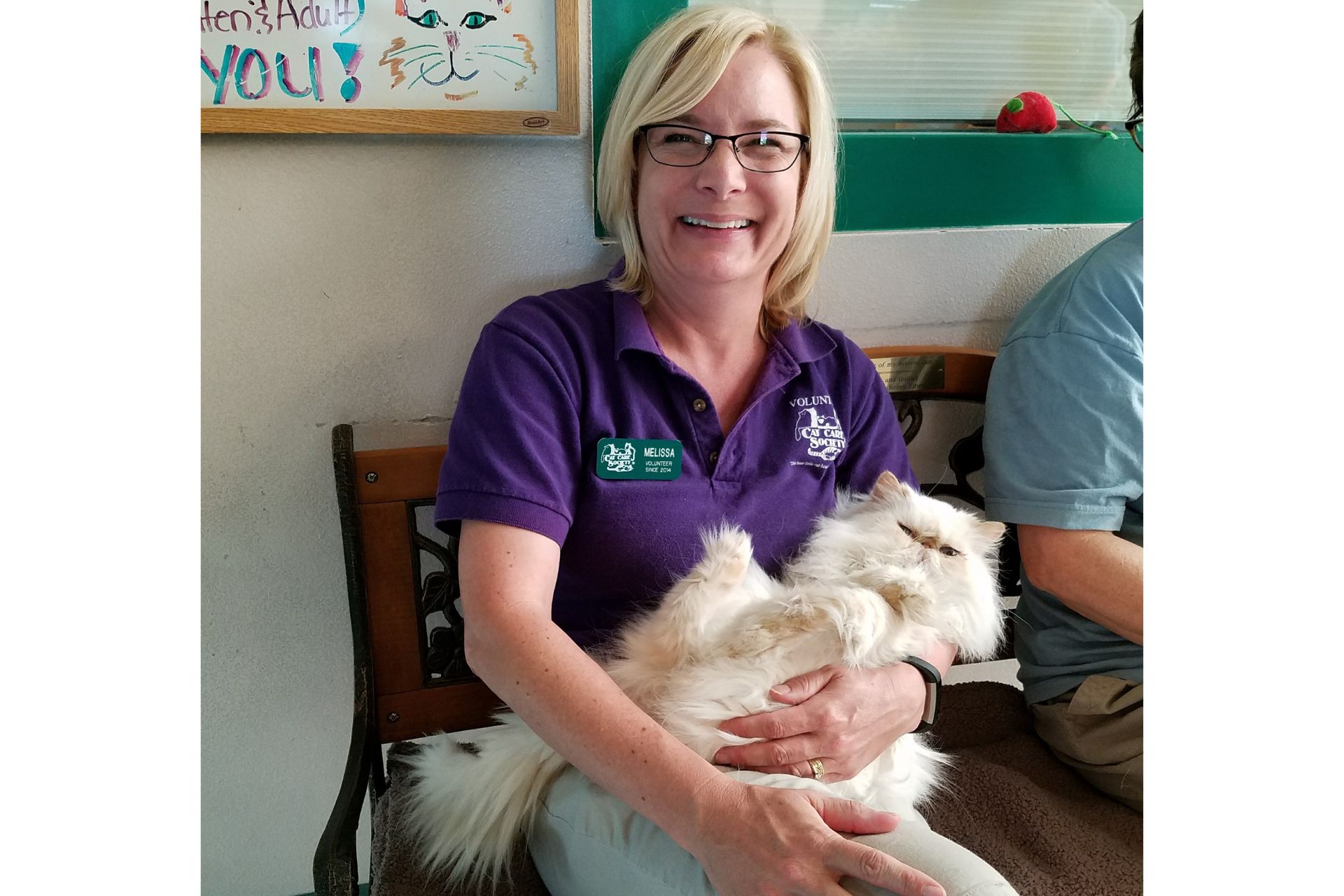
Cat Care Society is lucky to have hundreds of incredibly dedicated volunteers, many of whom have been staples around the shelter for years or even decades. One long-time volunteer is about to approach her 10th year!
Melissa Colsman began volunteering with CCS in 2014, originally drawn to spend time here after she first visited when looking to adopt a new kitty. It was the atmosphere of all of the cats roaming, playing and lounging that drew her in. Since her first CCS introduction, Melissa had adopted three CCS cats, and her parents adopted two. “The love and care for all of the cats is apparent in everything from the shelter design to the adoption policies to the focus on housing cats who have more needs,” she said. “I love being able to go to the shelter and interact with cats so readily. You can feel the love at CCS!”
Melissa’s first volunteer gig was our nursing home program, in which she brought shelter cats to senior centers for snuggles (a program that ended when the pandemic hit). Later, she was trained to be an adoption assistant, which provided extra help to staff on busy weekends. There, she helped greet clients, orient them to the shelter, provide information about adoption and link them to staff to start the adoption process.
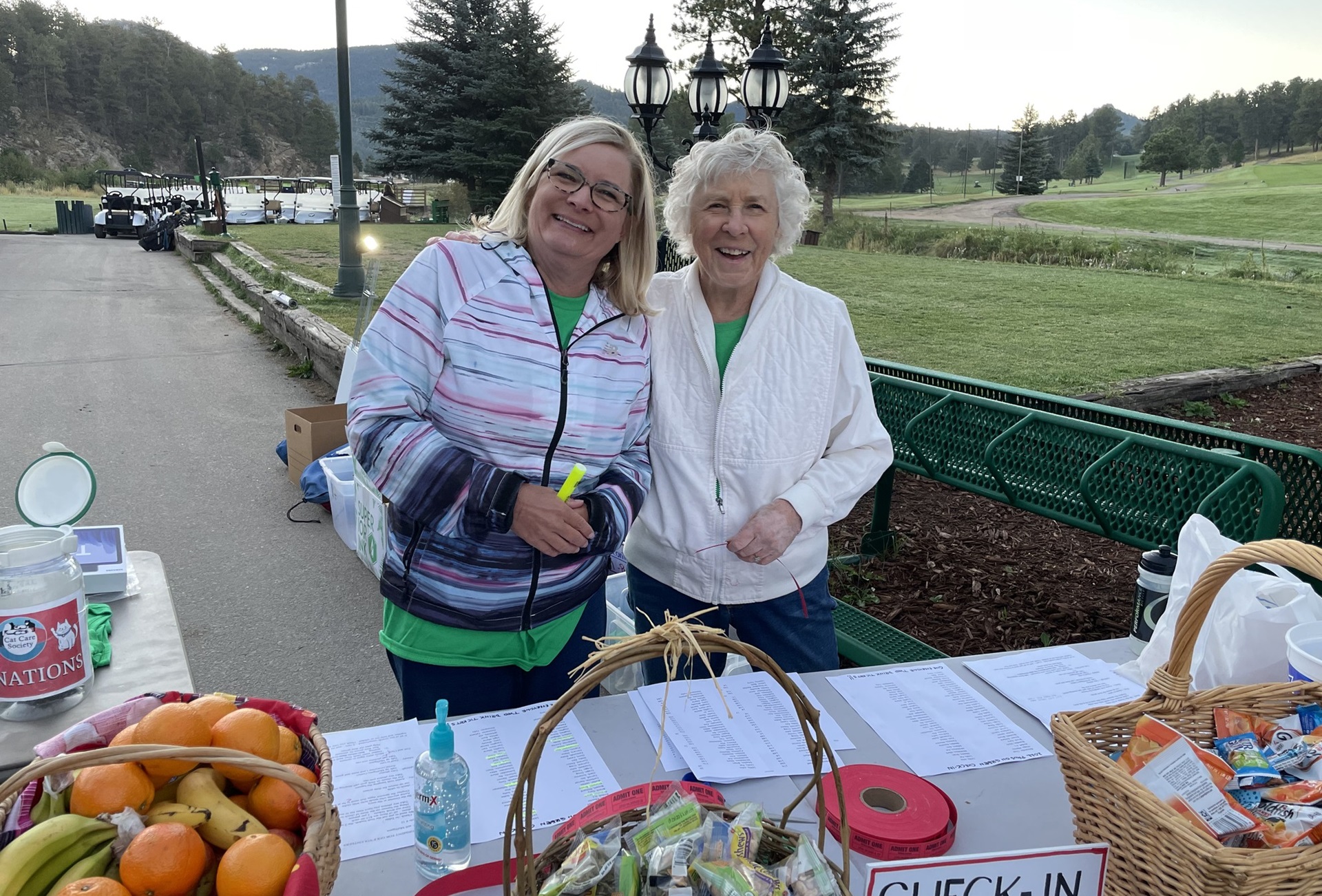
In 2022, Melissa retired after 34 years as an educator. At that time, she started working with another volunteer, Erin, to assist with our on-site store, Meow Mart. Together, the two keep it stocked, price new items and assist with inventory — while making plenty of time to snuggle all of the kitties. “I just have a great time with my Meow Mart partner, Erin,” she said. “We laugh, problem-solve, and have fun helping Mandy keep [it] running.”
Melissa also helps at various events like Santa Paws and the golf tournament, both of which are great fundraisers for the shelter. “With each job, I’ve been able to see that I’ve been able to help staff and clients have a good experience at the shelter,” Melissa said. “It’s gratifying to be able to help, even if it’s just keeping wand toys stocked so cat owners have ways to engage with their fur babies. It feels good to help an organization that you believe in. It’s one thing to provide funding, which is incredibly important! But it is also personally satisfying to be able to give my time, energy and love directly to the shelter.”
“We love having Melissa’s help around the shelter!” added CCS’s Volunteer & Events Manager Mandy Babb. “She is consistently reliable and has played such a crucial role in keeping things running for many years. I know that when Melissa is on hand at an event, or when she’s managing Meow Mart, that we can count on everything running smoothly. Her history here is invaluable, and her passion is evident in the work she does for the CCS cats, and we couldn’t thank her more!”
If you’re interested in volunteering, learn more and apply at www.catcaresociety.org/volunteer.

What a summer it was for us here at the shelter. From a very active kitten season to several unexpected surprises and multiple significant and successful events, there were definitely no dull days.
Summer is often the busiest time of year for shelters across the country. Kitten season, aka feline breeding season, typically occurs between late March and October. We see many kittens and momma cats in need during these months, and our incredible fosters take care of the little ones until they are 2 pounds, at which point they can be spayed or neutered and ready for adoption. From April 1 to September 24, 2023, CCS took in 342 kittens. Of those, 258 were adopted and many are still growing in their foster homes!
In August, we hosted a waived-adoption-fee event in honor of Clear the Shelters month, and were overwhelmed at the positive response from our community! That day we adopted out the most cats ever in a single day for our shelter: 31 cats went into loving homes. We also received incredible support from our partner organizations and individuals that ensured the day went off without a hitch. We can’t thank you enough.
We know that there were some concerns over the decision to offer “free” adoptions, and we appreciate the concern for our cats’ well-being. The decision to offer this was made after much discussion and consideration. Please know that we always do our due diligence. All adopters must fill out an application and be approved before bringing any cat home. We want to make sure all our cats end up in loving and committed homes, and we’ll never compromise these values. There have even been multiple studies done by respected animal welfare groups that have found that waived adoption fees do not affect animals’ outcomes in any negative way.
Throughout the month of August in total, we had a total of 132cats come into our care, and we successfully adopted out 141cats. In September, we helped 120 cats — 79 kittens and 41 adults, 13 of which were seniors — find new homes. As we reflect on the prior fiscal year, we also know that we cared for about 400 more cats than the year before. We are so excited to be expanding our ability to help more cats than ever, thanks to your support.
Speaking of stats, I also want to call out a national database called Shelter Animals Count. This platform brings together 6,936 animal welfare organizations to share credible and accessible data to positively impact our animals and communities. Participating in this allows CCS to offer data transparency and greater understanding of cat’s needs across the mountain region. With this knowledge, we can deepen our impact. I encourage you to browse their data to evaluate trends and know that we are supporting these positive outcomes.
I also want everyone to know that my door and phone lines are always open. If anyone has questions or would like any clarification on our statistics, policies or our animals, I would be more than happy to discuss it with you; just reach out!
Over and over again, I am beyond impressed with the dedication our employees, volunteers and donors demonstrate. Every single time we ask for something, someone delivers. I am humbled and so grateful for every one of you who shows up when we need it most. From the bottom of our hearts, thank you.

EC Michaels
Executive Director
Cat Care Society
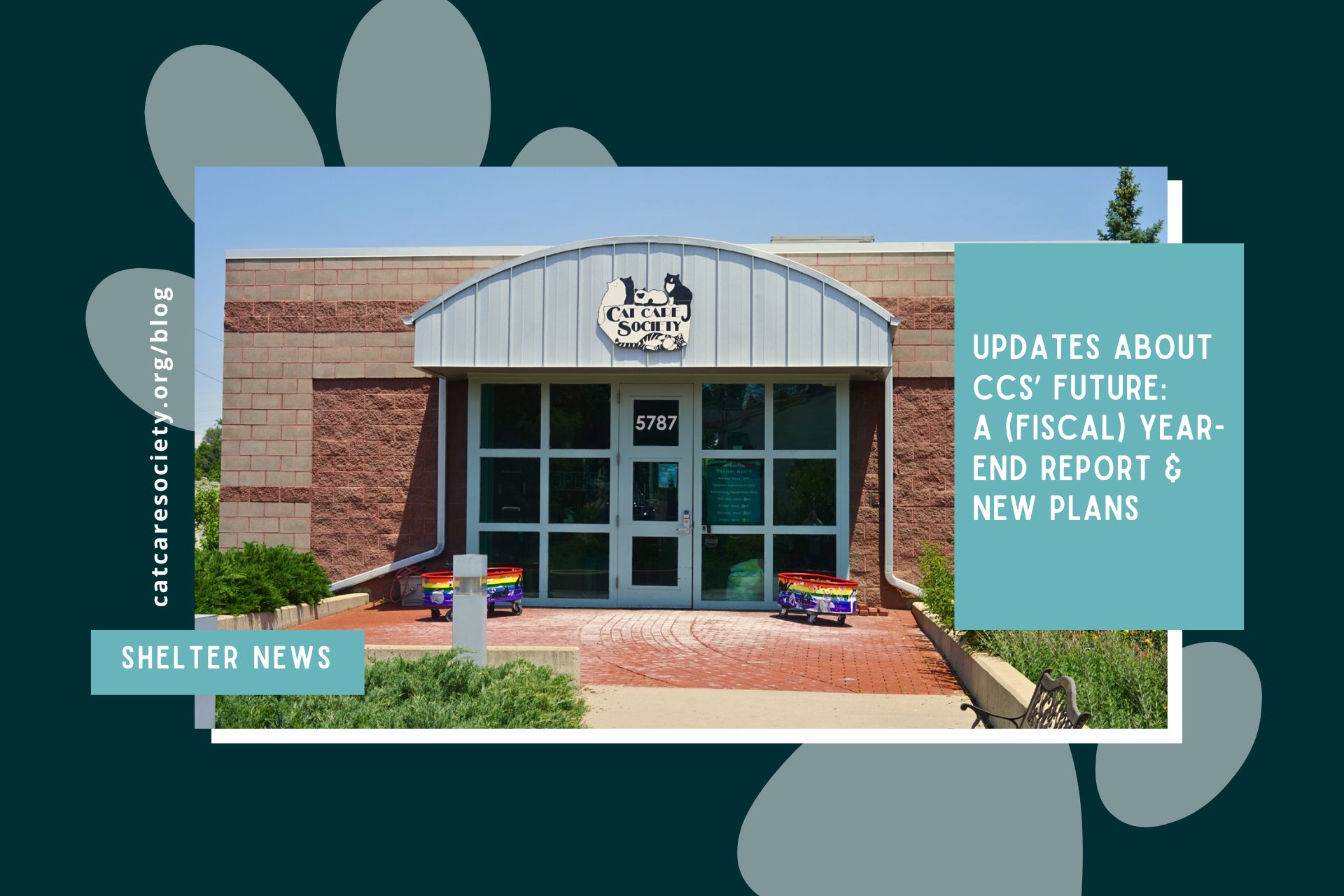
Hello friends of Cat Care Society! As I reach one full year of service with this incredible organization, I can’t help but beam with pride for everything we have achieved together and are still working to accomplish. And, I’ve got some great updates to share with you all.
CCS has so much rich history, and as we continue to drive ourselves forward, it was time to think big-picture as we go into the next era. So, to celebrate our past and expand on our offerings, we engaged in setting forth a new strategic plan. This ambitious plan helps us refine our identity and keep up with what’s needed in the animal welfare field and in our own community.
It started last February with a situational analysis of where we were, where we want to be and how to get there. We partnered with a company called Mission Spark, who conducted interviews with key staff and board members and guided a community survey that many of you reading this may have received. We were thrilled to see so many of you respond and offer your input — in fact, we had a higher-than-average response rate, which is a testament to the passion and dedication you all have. Thank you! We also took into consideration state and national trends, animal-related legislation and other peer organizations to make sure our services fit what our community needed.
The results of this work showed that we already had great dedication to the organization, strong core operations and a solid reputation among those who know us. What we discovered validated where we need to improve, which is in the areas of staffing, systems and structure, visibility and our facility.
After further analysis and a retreat with our board of directors in June, we began building a new visionary plan that focused on our guiding principles and perfectly reflected who we want to be and how we can best help the cats in our care.
What we’ve developed together sets forth a new comprehensive and cohesive identity, which embraces the building blocks that will propel us into a successful future. This plan went into effect at the start of our fiscal year on July 1, 2023, and we’ve already started the work to implement these new priorities.
But that’s not all. If you visit us online, you will see an entirely redesigned website with fresh content and new features to make it even easier to find the information you need. You may have also noticed a slight change to our logo, which features a cat with one eye and another one with one leg to reflect our values of caring for every cat, regardless of his or her condition.
Over the past year, we have also welcomed a few new members to our board of directors, who have already offered invaluable insight and experience to our leadership. Returning for another year as chair of the board is Mark Colsman, who has led this dedicated group of volunteers through a time of change as well as opportunity. We are so appreciative of all our board members have done to guide our organization forward.
I am also happy to share statistics from our most recent fiscal year, which ran from July 1, 2022 through June 30, 2023:
As you can see, more cats than ever need our help, and we’re doing all we can to step up to the plate. There is so much to look forward to as an organization and a community, and I just know that our years ahead look as bright as ever.
Rest assured that even with our new identity, there will be no changes to our existing programming. We are as dedicated as ever to serving cats and the people who love them!
Cat Care Society’s new strategic plan and identity couldn’t have come together without you, our loyal adopters, donors, volunteers, staff and community members. I am so grateful for everyone’s support and participation in helping us provide life-saving treatment and adoption services for the cats of Colorado.
Thank you.

EC Michaels
Executive Director
Cat Care Society
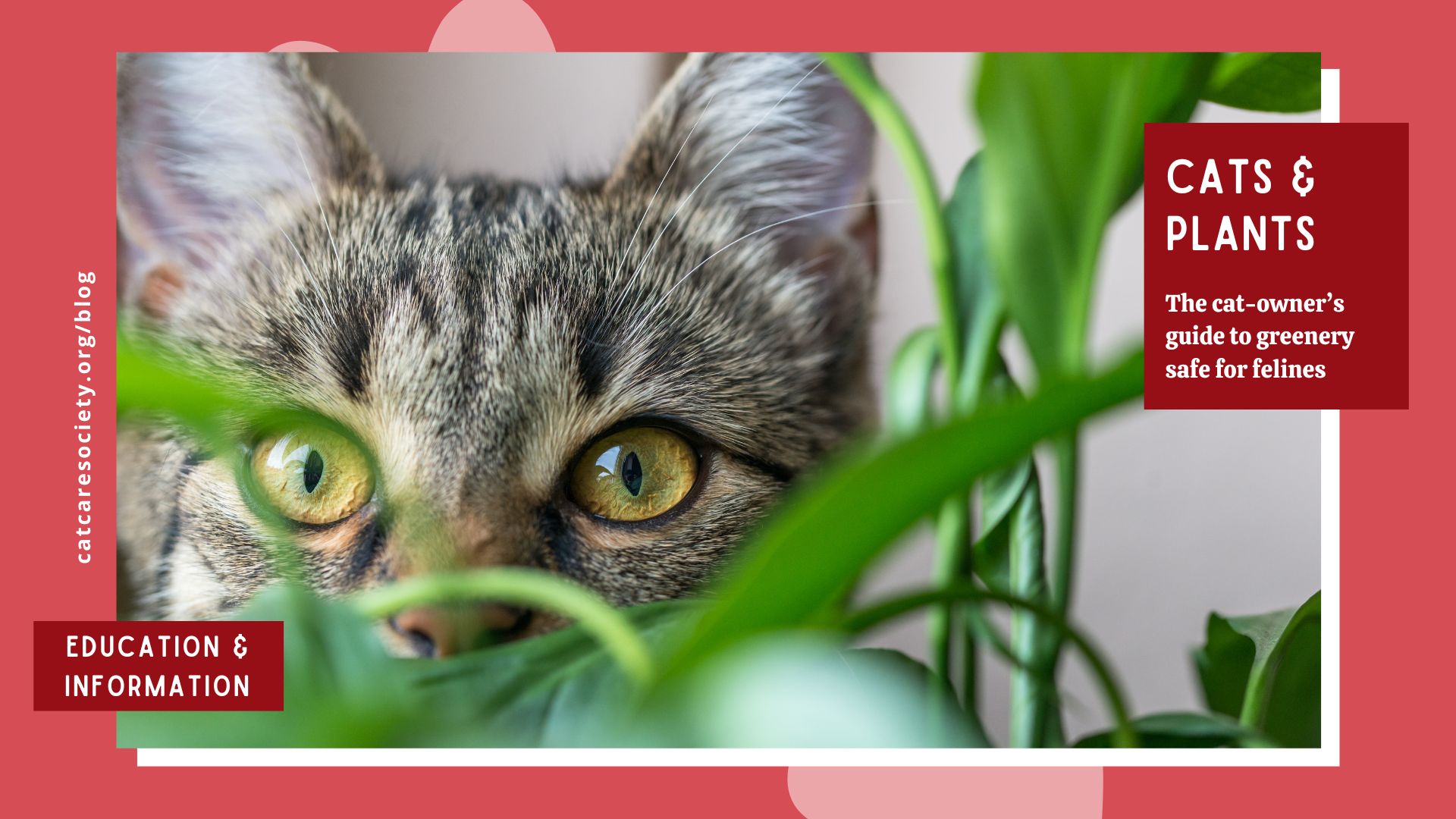

Enrichment is an important element in caring for cats, especially in the often-stressful shelter environment. CCS has always had a dedicated team of volunteer socializers and animal care technicians to support cats. But when two current staff members started, they saw an opportunity to increase the impact.
One animal care tech took an interest in feline enrichment and laid the groundwork. Kelly Cunningham, now our lead enrichment specialist, created an “enrichment calendar” to use with the cats. However, with few supplies, she had to get creative, collecting paper towel rolls, crinkly paper and pipe cleaners to provide enrichment on a shoestring budget.
Once Sonia Holmstrom, CCS’ foster & behavior supervisor, joined the team last year, things took off. With a background in animal behavior and experience in zoos, she has been hard at work creating our own behavior & enrichment program. Thanks to our recent partnership, we’ve implemented KONG’s toys in the shelter to create specialized enrichment experiences for the cats.
“Since the enrichment program found funding, we were able to get more supplies, treats and toys to stock the shelf,” Kelly shared. “The kitties are spoiled with the coolest and newest cat toys on the market! Everything we use for enrichment now benefits the cats by allowing them to feel safe, comfortable and confident enough to express their natural behaviors. We’ve already seen such an improvement in the overall happiness of our cats.”
“It has been fun to build a program that targets improved mental stimulation, exercise and socialization for cats in the shelter, as well as for adopted cats,” Sonia said. “We want to see cats expressing their natural behaviors while also strengthening a bond with humans. The enrichment program has also supported our efforts with cats who need behavior modification.”
“Our shy kitties come around at a much quicker pace than before,” Kelly added. “Many of the anxious and fearful cats come out of their shell faster, and it’s because we have a dedicated team of staff and volunteers who make sure these cats are enriched and happy. Before the program, it would take some cats months to show any behavioral improvement. Now, most of them improve in weeks! This can drastically reduce the length of time they spend in the shelter. Confident cats are adoptable cats!”
What’s the difference? Cat enrichment enhances overall well-being, while behavior modification targets specific behaviors for improvement.
A cat’s enrichment is tailored to their needs based on factors like age, diet, medical needs, behavior and personal preference. A successful tailored enrichment program provides:
“First, I consider the environmental enrichment,” Kelly said. “The rooms are set up to fit the individual needs of the cats to reduce stress and anxiety: Where do they like to hang out? Do they like vertical space? Do they prefer to have their own ‘corner’? In a multi-cat room, this is accomplished by splitting the room into smaller areas, each spot with its own bed, food/water and litter box so each cat can claim their own space and reduce tension over territory. The furniture is strategically placed to maximize the ‘cat superhighway’ space and allow for more vertical movement. I also consider what kind of bedding they prefer, if they sleep up high or down low, if they hide/play in tunnels or use them to cross the room unseen. Many cats prefer water fountains, which are great for environmental enrichment. A variety of scratchers are also a necessity for scent-marking. I make sure to include several different kinds of toys; I put battable toys of different textures, (crinkly, soft, jingle bell) on the floor and on high surfaces. I also set out solo play toys, such as the ball & track type or interactive/motion toys. Finally, I leave out treat puzzles for cognitive stimulation. Before I leave the room, I engage in hunt and play sessions with the kitties. Our enrichment charts have a spot for comments where we write the cat’s preferences or favorite toys, which has been helpful in deciding what to use each day.”
Kelly’s favorite recent success story is Holly and Chloe, a pair who came to CCS extremely fearful and reactive. Because of their age and some medical issues, at first we did not believe they would have a successful outcome. Kelly began to visit them several times a day, playing David Teie’s cat frequency music while sitting on the floor, offering a Churu treat and some calming words and pets with a telescoping brush.
“Chloe seemed to be a bit more social and less reactive than Holly, but I was still determined to help these two feel safe and happy,” she explained. “Holly moved into her own room and relaxed only a tiny bit, so she went to a lovely behavior foster who put in so much time and effort helping her come out of her shell. Truly, Holly’s behavior would not have improved without the help of our foster. In the meantime, Chloe was moved into the shy cat room. I visited her several times a day and gave her lots of treats and attention. For a while she would remain in the hidey cube and let me pet/talk to her, but after two weeks, she would come out of the cube to greet me and solicit pets. Then I began short play sessions and offered treat puzzles (which I discovered she absolutely loved). A month or so later, Chloe had improved remarkably and was greeting most people who entered the room and showed her some attention. Holly came back from foster and joined her sibling in the room. I used the same methods on Holly then; consistently going in to sit with her, establish trust and build confidence. About a week before she got adopted, she was also coming out of the hidey bed to greet me when I approached. I truly believe these two became so confident and happy because of the dedication of our love, attention, time and enrichment we provided for them during their stay. I’m so happy they both found their forever homes. I’m so proud of how far they came!”
There can be misconceptions about what enrichment for cats. Though cats can be independent or aloof, that doesn’t mean they don’t need interaction. “Enrichment is necessary for the physical and emotional well-being of cats, which is more than just playing with them,” Kelly said. “Enrichment provides an environment that is comfortable, safe and stimulating. Enrichment gives cats the confidence to be their best selves. Imagine if you lived in a house with nothing to entertain you or make you feel at home! No comfy beds or couches, no TV, no video games, no snacks or hobbies. Life would be pretty boring. Cats are no different, and it’s our responsibility as pet owners to give our animals a fulfilling, happy life.”
To learn more, visit our Behavior & Enrichment program page!
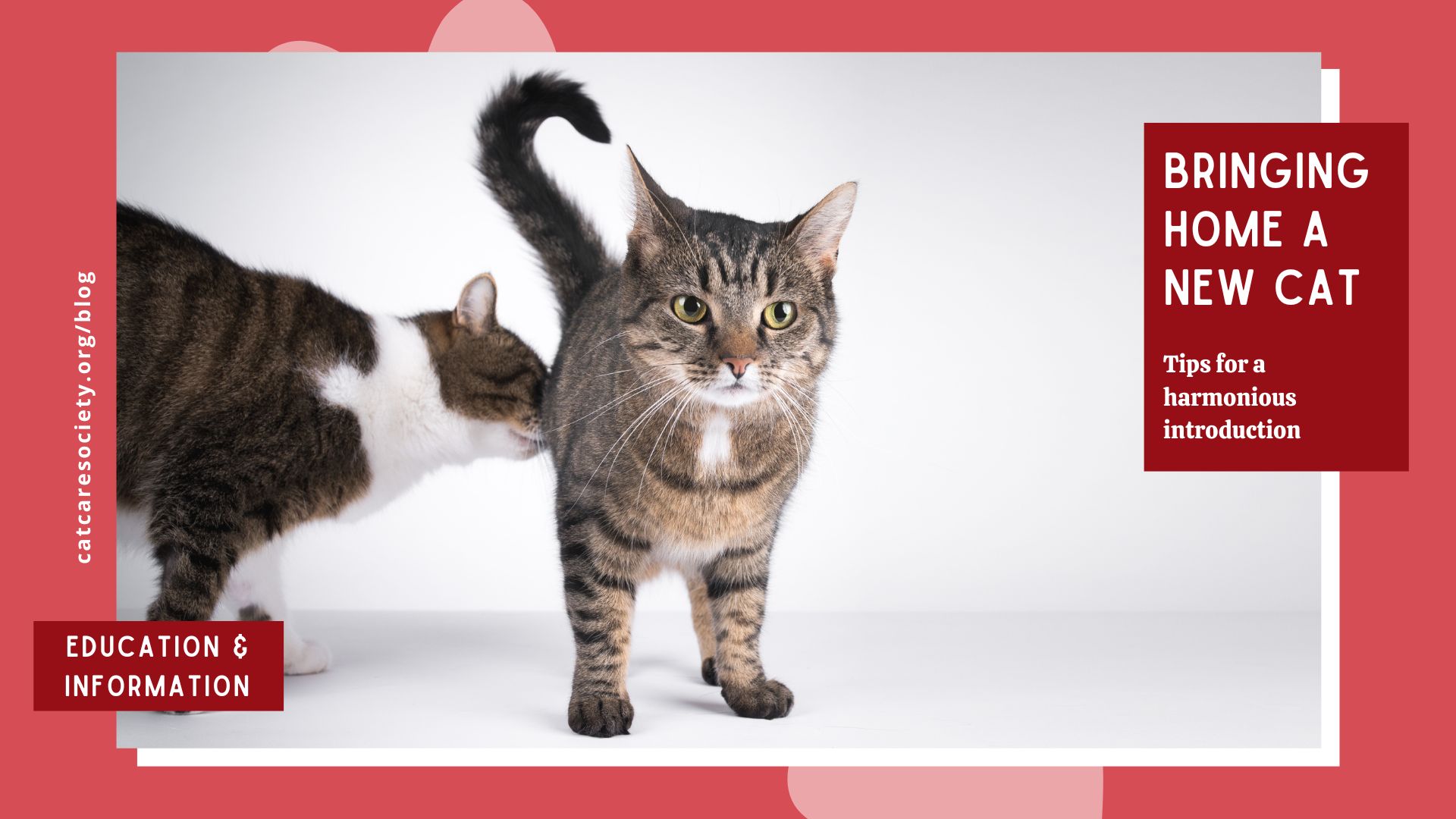

It’s another busy summer season here at Cat Care Society. As is typical for this time of year, we are seeing a rise in requests to take in cats as we — and many other shelters — navigate the influx of kittens. As we head toward the final peak of the season around October, we also have several irons in the fire for CCS’ future. You may have noticed some construction recently as we install a new elevator. More special projects are in the works to ensure our building can best serve the cats in our care.
In our summer 2024 Cat Care Quarterly, you will find several articles about cat behavior and enrichment — two topics that we’ve been focusing on lately that you will hear more about! It’s so important to us to offer experiences that help build the minds and bodies of our feline friends so that they are happier, healthier and more adoptable.
But there are actually some common misconceptions about why exactly enrichment matters. In fact, research about cats has been significantly behind what has been done for behavior modification in dogs. Why is this? While there is a long and varied list that has brought about this lag, much of it is related to the idea that cats are more independent and not as social as dogs.
Posing a potential risk to the public, animal welfare policy has been directed at statutes focusing on dogs as well as the creation of animal shelters to house them. This focus is partially why they’ve received the bulk of behavioral research! Unfortunately for cats, they haven’t received the same level of support until recent years.
Throughout my time working in shelters, I’ve seen a few trends play out. Dog owners experiencing unwanted behaviors often think about working with a professional to resolve an issue. Plus, it’s easier to find a dog trainer than a cat behaviorist. Cat owners are more likely to view a problem as unfixable (or too hard to fix) and rehome or surrender them.
Some shelters don’t take in cats in the first place, and even more aren’t able to offer formalized enrichment to the cats in their care due to capacity. The flip side of this is that cats are more at risk for health issues in shelters because they don’t handle stress well. Additionally, behavior exhibited by cats is often labeled incorrectly, limiting our ability to create possible interventions and support plans.
That’s what we’re trying to change. By building a comprehensive cat enrichment and behavior program, we hope to begin slowly changing the narrative and evening out these trends. Cat Care Society has long been dedicated to supporting cats and their owners through adopter education and seminars. But now, we’re ready to take it a step further. We want to up our game and offer better avenues for cats in our care to exhibit normal behaviors. The opportunity to learn to trust humans, to play with toys, stimulate their senses and increase their physical and mental development, is something we are so passionate about and excited for.
When we take in unsocialized or fearful cats, we’ll now have a system for them to gain confidence faster, to address their needs in meaningful ways and create opportunities for those who have a need that has gone unfilled.
We couldn’t do this work without the support of our partners, though. We are so thankful for the other shelters in our area who trust us to take in their animals and work with them successfully. Because other rescue groups — especially those in rural areas — don’t have the same resources, we welcome their animals to our facility to work with our medical and behavioral team and have a real chance.
We have seen countless animals who weren’t thriving in other shelters or a prior home come out of their shells and completely transform once they’re in an environment that offers them the space and support to blossom. No shelter is the same as a home, but the closer we can get to that, the better a cat will do. Our free-roaming spaces and enrichment opportunities means that these kitties can become their true selves, find their natural behaviors and let their personalities shine. This makes adopters be able to envision that cat in their home easier and have a more successful adoption story. And every adoption — and foster home — means that we are able to help one more cat have that same opportunity.
If you’re looking for more information on cat enrichment or need help finding a behaviorist, please visit our website’s Resources, Enrichment and Blog pages, or reach out to talk to us about how we can help!
More Resources

A woman full of life, love and light, another Cat Care Society supporter, Leanne Emm passed away this past March.
A fourth generation Colorado native, Leanne was known for her sense of adventure, intellect and devotion. With decades of public service, she held roles in city and county government, going on to lead as the deputy commissioner of the Colorado Department of Education. When she wasn’t working, Leanne loved fitness, river rafting, watercolor paintings and napping in the sun with her cats (four of them adopted from CCS!).
Leanne served on CCS’ board of directors in 2017, and after retiring from her career in 2018, stepped into a larger, critical role as interim executive director. “It had been a turbulent couple of years for CCS, and Leanne was such a positive, steadying influence,” remembers Clyde Dawson, another long-time board member. “And what a sense of humor! As it turned out, one of the most important contributions she made to CCS was organizing and conducting the search for a permanent ED. She was an avid whitewater rafter and had been looking forward to river-running nearly full time in retirement. She also remained a strong supporter of the organization.”
Clyde recalls Leanne as a tremendous asset to CCS — “exceptionally intelligent, with a keen grasp of finances and management issues of all sorts, as well as warm and engaging,” he said. “I think she won us all over when she wrote in her board application that one reason she was interested in board service was that it would give her an excuse to come into the shelter more often and play with the cats!”
Leanne’s daughter Charlotte says that her mother loved cats her whole life, that they were a really grounding thing for her. “She just loved all animals, and cats were her favorites — that and baby goats and horses!” she said. “She loved CCS and seeing how happy people were when they got to bring a cat home.”
Leanne’s last update in the summer 2018 Cat Care Quarterly oozed her warm, bright personality and gratitude. For everything that she brought to our organization and the world, we’re grateful for her, too.

A long-time Cat Care Society supporter and leader, Gail Tinianow, passed away this spring, leaving behind a commitment to cats and a love for travel.
A child of Air Force parents, Gail was born in New York and lived in various parts of the U.S. and Spain. Early in her career, Gail worked for the federal government in Washington, D.C., and eventually earned a degree in business administration from Arapahoe Community College. She and her husband Marty married in 1985; she retired in 2006. Marty shared that Gail’s love of cats was extensive.
Her retirement marked the start of a 10-year dedication to Cat Care Society, when she began looking for volunteer opportunities. Jane Dorsey interviewed Gail to work in Cajun’s Closet, Cat Care’s thrift shop, in 2008. In 2011, she joined the board of directors to help ensure the financial success of CCS. Over the next several years, she would go on to hold roles of secretary, vice president, and president. In those days, CCS had a working board, recalled Ken Dobrovolny, so Gail was hands-on in the day-to-day operations of the shelter “and ran a tight ship.”
Jane Dorsey recalls Gail’s enjoyment of the Santa Paws Festival and the role she played in the planning committee. “I remember her bringing detailed records of everything from the prior year and challenged us to make it even better,” she said. “She was so enthusiastic about everything she took on, and that made it fun to work with her.”
Gail also generously donated a trip to her timeshare in Hawaii for the Tails of the Painted Cats auction more than once. “She was so excited when she came up with the idea of pairing a trip with a Hawaiian-themed sculpture,” Jane said. “Artist and volunteer Pat Lickly created the Hawaiian cat, and we had fresh flower leis made for Gail and the high bidder that night. She loved that event and whole-heartedly supported it.”
In the winter 2016 Cat Care Quarterly as board president, Gail wrote: “Our first order of business in the new year entails recruitment of an executive director. Your board has been running the Society since 2011, and I’m happy to report that we are now financially strong enough to fill this position. I’m simply honored to be at the helm of this great organization and cannot express enough appreciation for our amazing donors, volunteers and staff.”
Gail eventually stepped back from the board in 2018, but we will remember her for many, many more years to come.

Abandoned, neglected and wounded after surviving a house fire, Fish Stick was found by a kind neighbor just in the nick of time. Little did anyone know, he was already up against more struggles than met the eye.
Believed to be the only surviving pet, this senior Siamese mix was down to 6 pounds and in dire need of medical attention. Realizing the level of care he needed, the neighbor reached out to our friends at Cooper’s Companions Animal Rescue for help. They brought him to Cat Care Society, knowing our specialty in helping cats that others would give up on.
Fish Stick had severe lesions on his face, neck, back and paw pads. He immediately received antibiotics, fluids and pain medication. He needed a cone to stop scratching at the sites.
Without veterinary treatment for so long, Fish Stick’s wounds were infected and bleeding.
“His teeth were horrific, his skin was falling off, and he was just a complete mess,” our lead veterinarian Dr. Cecily Palamara, recalled.
Further exams revealed he also had a heart murmur, severe periodontal disease, conjunctivitis, upper respiratory infection, anemia and about 8 more underlying conditions. Not to mention a positive ringworm test. Add to that, he was blind in one eye from a previous trauma. We called it his wizard eye.
Considering his multitude of issues, a successful long-term outcome was unclear. Our goal shifted to maintain his quality of life while treating what we could.
From the start, Fish Stick was a total lovebug. Regardless of any pain he felt, he maintained the sweetest disposition, purring constantly and rubbing affectionately on staff during every treatment. It seemed he was up for the fight.

After addressing his most urgent needs, we slowly started ticking concerns off the list. Within a couple weeks, we saw significant improvement. He was gaining weight, hydrated again, his conjunctivitis was resolved, and his skin was looking better. Test results showed that some of his skin issues were not burn related, but were actually allergies. A month in, his liver values were completely resolved, anemia was on the right track, but his lymphocytosis was worsened.
Just when he took one step forward, there were another two steps back.
One employee stepped up to foster Fish Stick for close monitoring and an aggressive medication regimen.
After numerous medical setbacks, Fish Stick turned the corner in his foster home.
In foster, Fish Stick began to thrive. Just weeks in, he was markedly improved on nearly all accounts and finally clear of ringworm. His fur grew back in and he was at an ideal weight.
“He kind of became a celebrity,” Dr. Palamara recalled. “The whole team would come down for his rechecks. Every time we saw him, he looked better and better. He just needed some time and TLC, and he got that here.”
About 100 days after he came through our doors, Fish Stick was ready to become a candidate for adoption — with no less than 14 medical disclaimers. To make sure his adopter knew the extent of his conditions, a consult with our vet was required.
A host of medical issues was no concern for his adopter ready to open his heart and home.
Michael came to the shelter looking for a Siamese cat after losing his own. He learned about Fish Stick’s history and ongoing concerns but was unfazed, willing to take on whatever came with this friendly boy.
After going home with Michael, Fish Stick settled right in. He even gained a new friend, as Michael adopted another CCS cat, Jack, from us the same day.

“Every day, both cats are getting more comfortable, and I’ve spent a lot of time playing with them,” Michael updated. “Jack is renamed Taz after the Tasmanian devil since he runs around like a tornado. Both cats are super smart and such a joy.”
Looking at him now, you’d never suspect Fish Stick made it through such a horrific event. The time and energy we put into this cat was significant, and his glow-up is a perfect example of who we are and what we do best. All in all, the cost of Fish Stick’s medical care alone was near $3,000. This does not include everyday expenses of living in a shelter, such as his food, litter, supplies or staff time.
Fish Stick pioneers a way for so many other cats who deserve a second chance after a bleak outlook.
We simply wouldn’t be able to take care of cats like Fish Stick if it weren’t for your support. Your tax-deductible donation ensures that more cats facing the worst have a chance at finding health and happiness in a new loving home.
With hope and gratitude,
EC Michaels
Executive Director
Cat Care Society
P.S. Thanks to you, Cat Care Society was able to help over 1,000 cats last year! Because we rely 100% on donations to keep up, we need your help to find loving homes for cats in need.
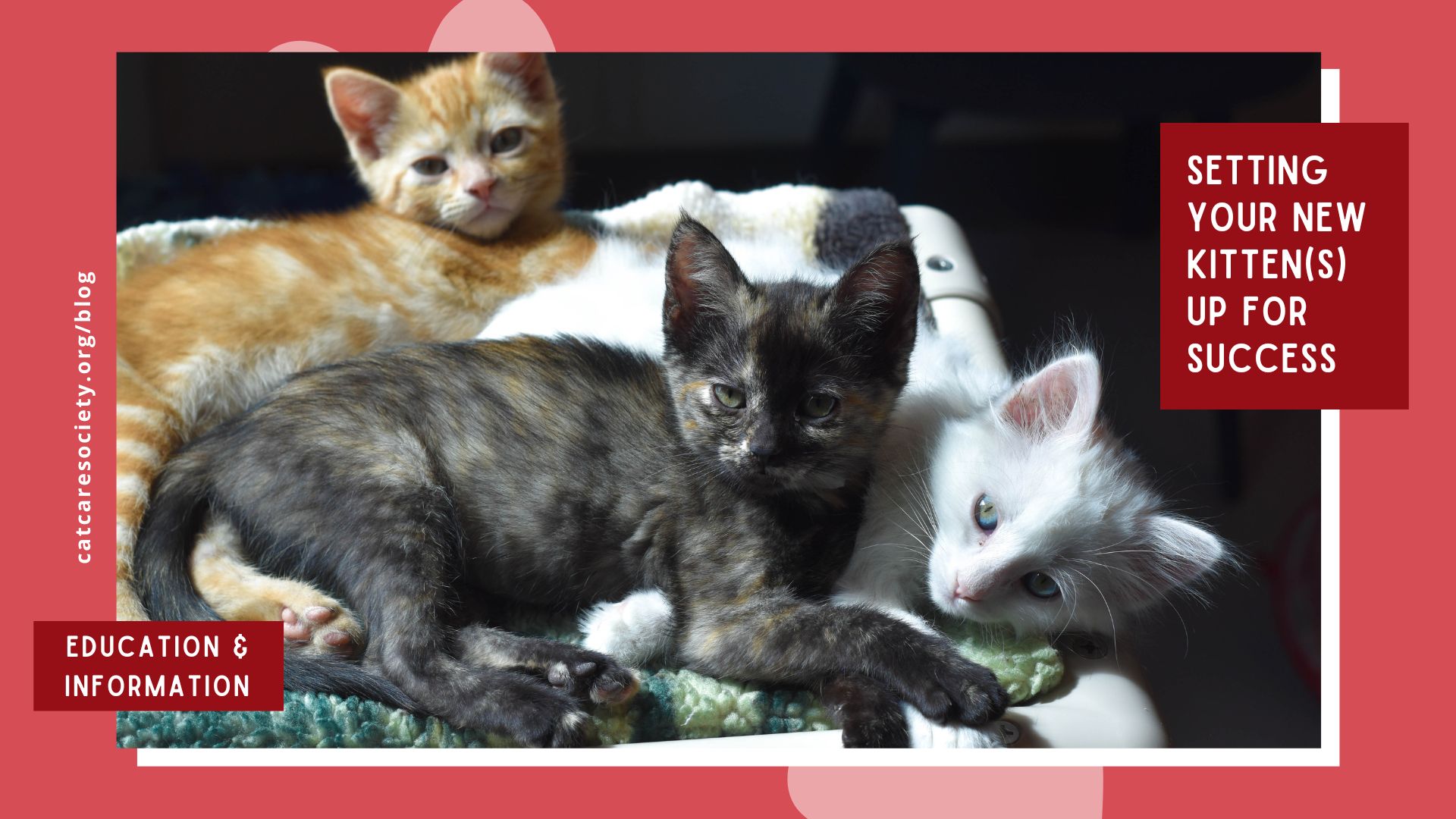
Jump to: Why 2 Kittens Are Better Than 1 | What’s the Deal with “Kitten Season?”
So you adopted — or are thinking about adopting — a new kitten. Congrats! These tiny furballs bring so much love and joy to a home, but they also need quite a bit of care! Without proper support from the start, your little one may develop some bad habits that are hard to break as adults.
We all know that kittens bring lots of energy and are oh so cute, but caring for a baby cat goes well beyond just playing with the little fluffy ones. Here’s what you most need to keep in mind when bringing a kitten into your household.
Socializing from a young age helps make everyday items more normal and creates less fear. Less fear in cats creates more confident and comfortable cats who can adapt to change and have fewer behavioral problems later in life. This also helps you create a stronger relationship with your cat!
It’s also a good idea to begin desensitizing them to things like grooming and handling to begin building positive associations. Ask a friend to help feed them while you trim their nails or brush them. Gently look in their ears, eyes and mouth like the vet would do.
Leave a carrier out for them to get used to, and move it around the house. Put treats or feed meals there, and use it for transportation to playtime sessions.
According to Billie Reynolds, owner of Good Kitty Behavior Consulting and Training, a cat’s period of socialization with non-littermates best happens when they are 7-14 weeks old. This is when social and object play increases their coordination and social skills and can happen directly with themselves, with people or with other animals. It can include climbing, hugging, ambushing, licking, pawing, mouthing, holding, chasing, pouncing, leaping and dancing.
We don’t yet want to discourage natural behaviors like rabbit kicking because kittens are practicing, but we can redirect unwanted actions onto appropriate items.
Make a point to offer interactive play on a routine basis with your kitten. It’s best to aim for toys that mimic natural prey or predator interaction (such as a bird, bug or mouse). Fishing poles and Da Bird are two great options. Aim for about 10 minutes per play session. After playtime, offer a high-protein snack, which is what they would enjoy as a reward after hunting in the wild.
If you have multiple kittens, offer each individual, interactive play time.
When kittens reach 3 to 6 months, they begin learning about their environments and other species. This is when they absorb how to live in a home with humans!
From 6 to 18 months old, kittens have become adolescents and have reached their highest need for energy release and mental stimulation. It marks the beginnings of sexual behavior, so we highly recommend they be spayed or neutered well before this time. If there are other cats in the home, watch for territorial behaviors and add new territories like cat trees and towers, water and food bowls, litter stations and sleeping spots as needed.
When cats reach 18-30 months, they’ve become early adults and begin to establish their own territory. Be sure to continue interactive play and provide plenty of territory options for all cats in the home for the rest of their lives.
To maintain interactive play, you can also add enriching experiences like puzzle toys and feeder balls. When picking out toys, consider your cats’ specific behaviors like whether they use their mouth or paws more when playing. You can even make your own toys using common household items (for ideas, check out this post from ASPCA)! To dig deeper into feline enrichment, check out our partnership with KONG!
How do you know if all of this is working? If your cats seem happy and you don’t have conflict, you are on the right track!
One of the best ways to support the behavioral and emotional development of a kitten is to make sure they’ve got a friend. It may be hard to believe, but two kittens are actually half the work of one! Take it from Kitten Lady, who says one kitten is half a kitten, and two kittens are a whole!
Because kittens thrive when they have feline friends, we recommend adopting two at once — or one if you already have a young, playful cat at home. CCS even has ongoing adoption pricing for this! One kitten’s adoption fee is $150 but two are just $200.
Kittens learn by observation and pick up skills like using the litter box when their pals exhibit that behavior. They also are able to channel their playful aggression on each other rather than an unsuspecting human or piece of furniture. For instance, if one kitten wants to use its mouth and bite down on its sibling, the other cat may scram, and that kitten then learns to be gentler when playing.
Not to mention, cats are social and enjoy having other cats nearby. It’s why we have community cat colonies! After all, it’s comforting to have someone their own size to snuggle with and help them feel comfortable in their surroundings.
If you’ve ever heard the term “single kitten syndrome,” it refers to a kitten who didn’t have litter mates or sometimes even a mother around to teach appropriate behavior and boundaries. Like humans who grow up as only children, they tend to miss out on experiences and activities that siblings go through together. In short, everything they learn as a kitten from the cats around them set them up for more success as an adult.
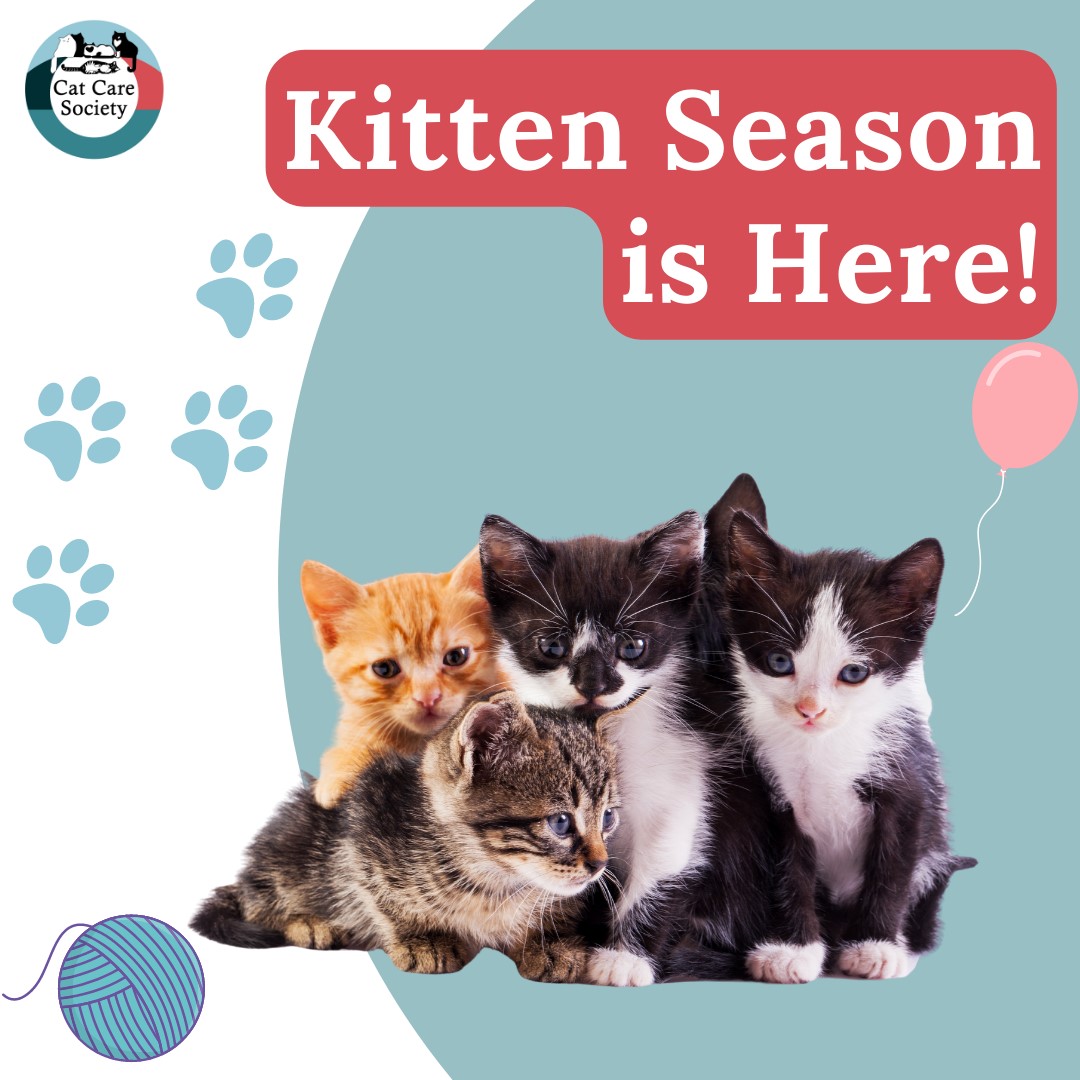
You’ve probably heard the term “kitten season,” but have you ever wondered why kittens are more plentiful during a certain time of year? Just like how humans find certain activities like camping or gardening easier during the warmer months, cats too thrive when the snow starts to melt away.
The days are longer, and there are more resources in the summer (did you know that mice tend to hibernate in the winter?). In climates where there is no winter, places like Florida actually don’t have a kitten season, because it lasts all year there.
Kitten season, or feline breeding season, typically takes place around March through October, and many shelters experience the bulk of their cat and kitten intake during this time. In 2023, Cat Care Society took in 516 kittens!
Momma cats are pregnant for about 60 days. And considering they can have multiple litters a year starting before they even reach 1 year old, it’s no wonder our communities are crawling with cute little kittens. This is why spaying and neutering and TNR work is so important in reducing the stray cat population! If the kittens make it to a shelter or vet, once they reach 2 pounds, they are spayed or neutered and put up for adoption.
Because kitten season is the busiest time of year at the shelter, we rely on our community to help us keep up and save more lives! If you want to get involved, please donate items or funds to support our work, adopt a cat of your own, or consider opening up your home as a foster.
To better understand what to do with a stray, please see our blog post, “So You Found a Stray Cat, Now What?”
To learn more about cat behavior, please consider signing up for an upcoming free educational seminar at the shelter, held on the fourth Saturday of the month at 10 a.m. Find a list of upcoming topics on our website.
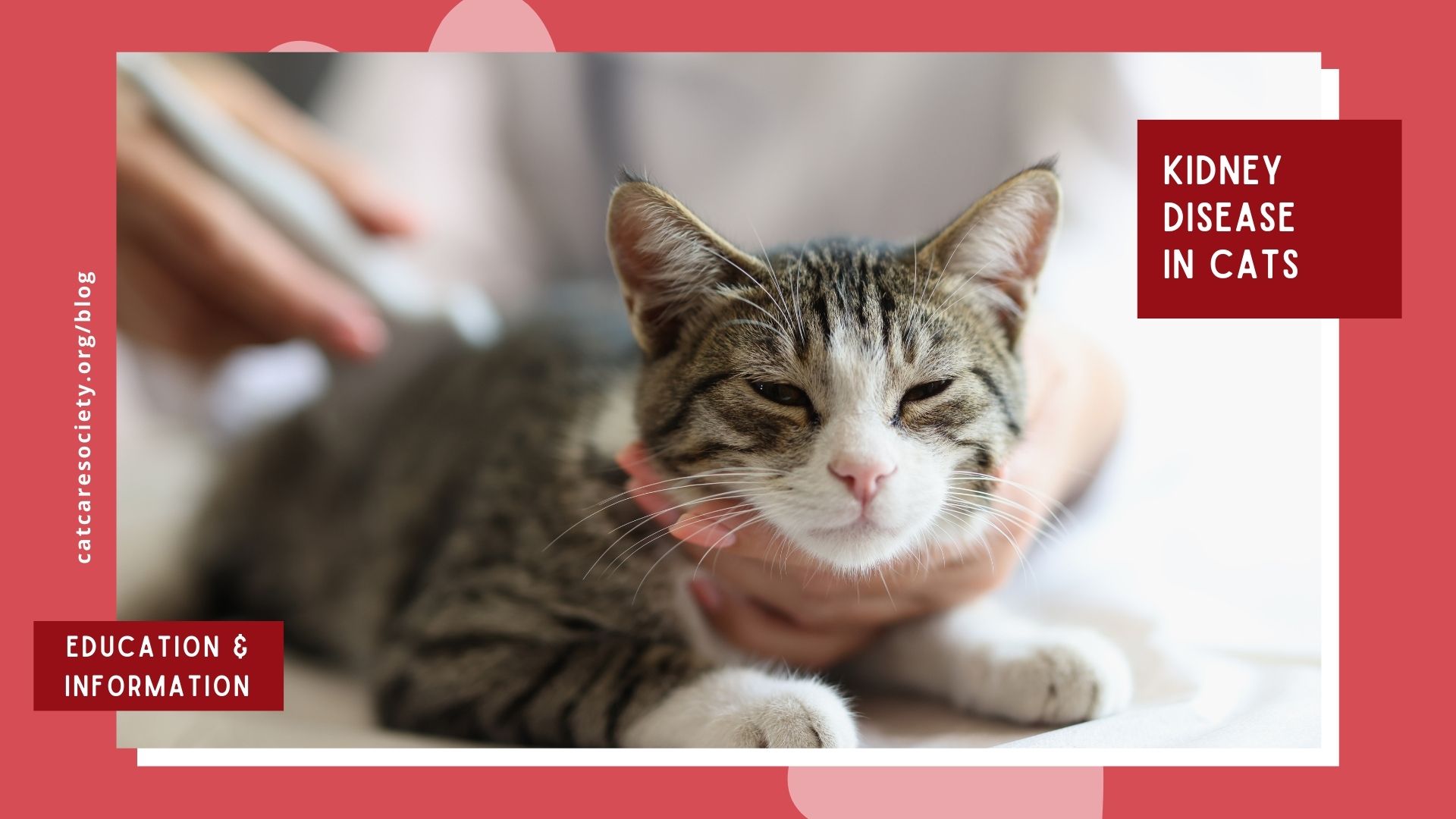
Kidney disease, also known as chronic kidney disease (CKD), affects a significant portion of aging cats. It’s estimated that CKD impacts 30-40% of cats over the age of 10 and 81% of cats over 15. While there is no cure for it, fortunately, early detection and proper management can significantly improve their quality of life. Here, we will explore the prevalence of kidney disease in cats, why it’s so common and ways it can be managed.
First, let’s distinguish between chronic kidney disease (CKD) and acute kidney injury (AKI). CKD develops gradually over time, and is a degenerative, progressive condition. AKI is a sudden and severe decline in kidney function, often triggered by specific events like toxins or infections. AKI requires immediate veterinary attention and involves a different treatment plan compared to cats with CKD.
Just like a water filter keeps your home’s water clean, healthy kidneys act as your cat’s internal filtration system. As they age, these filters can become less efficient, leading to a buildup of waste products in the bloodstream. Kidney disease progresses through four stages, each indicating the level of kidney function remaining. Early detection and proactive care are essential for supporting kidney health and preserving function for as long as possible.
While the exact reasons behind the high prevalence of CKD in cats are still being explored, here are some contributing factors:
Purebred cats tend to be more susceptible to CKD because of genetic components, but most all cats over the age of 10 will develop some extent of CKD.
The good news is that with early detection, managing kidney disease becomes significantly easier.
What signs should you watch for that may indicate kidney disease?
Having just one of the symptoms listed above doesn’t necessarily mean your cat has CKD. Your veterinarian will perform a comprehensive physical examination and run blood and urine tests to rule out other issues such as UTI, diabetes and crystalluria (crystals in urine made up of minerals and other substances that join together rather than staying dissolved). In some cases, an X-ray or ultrasound might also be necessary for a definitive diagnosis.
If your cat is diagnosed with CKD, your vet will be able to tell you how far along the condition has progressed within four stages:
“Usually, two-thirds of kidney function is gone by the time it shows up on bloodwork,” CCS’ Lead Vet Dr. Cecily Palamara said. “If we’re not seeing it, we know it doesn’t necessarily mean a cat doesn’t have it. Cats can compensate for it for a long time.”
You can learn more about the stages of CKD from the International Renal Interest Society. Blood work analysis is a crucial part of diagnosing kidney disease and tracking its progression. If you’d like more information on what blood work is necessary and what it means, check out the Cat Manny’s page on CKD.
While there’s no cure for kidney disease, there are several things you can do to help manage it and improve your cat’s quality of life:
Managing chronic kidney disease in shelter cats presents unique challenges compared to home settings, such as providing special diets and working with limited space and resources.
Dr. Palamara shared the approach she and her team take to support these cats. “We really have kind of a breadth of treatment and a very wide approach,” she said. “The main goal with the approach to our kidney cats is, how do we maintain and lengthen their quality of life for the time that they’re with us? How do we decrease the amount of time that they’re with us? And what’s their fastest path to adoption? That can mean different things for different cats.”
The shelter medical team focuses on addressing side effects, maximizing hydration, keeping the cats on canned food because it has a higher water content, and providing individualized treatment plans while working within the limits of the shelter environment. For cats who struggle to get enough water, they provide subcutaneous fluids. They put cats on special renal diets when needed, but they have to be mindful of space, because those cats need to live in a separate room away from the rest of the cats on a regular diet.
Mineral management in kidney cats is also important. If phosphorus gets too high, it can be very toxic to the kidneys. There is a special medication that can be added to food to help lower phosphorus, but many cats don’t like it. Kidney cats are also prone to low potassium, which can cause weakness, but supplementation can help.
The team uses a unique approach for cats with anemia associated with CKD. They administer a newer FDA-approved medication for anemia secondary to kidney disease in cats, and it has been very successful. It’s a more expensive treatment and is reserved for when anemia is affecting the cat’s quality of life.
Tailoring treatment to each cat’s individual needs helps them feel their best and thrive in their new homes after adoption.
Acute Kidney Injury (AKI), also known as acute renal failure, occurs when a cat’s kidneys abruptly lose their ability to function. This is a life-threatening condition that can lead to severe dehydration, rapid accumulation of waste products in the bloodstream, electrolyte imbalances and changes in blood acidity levels.
Common causes include:
The symptoms of AKI are similar to CKD and can also include vision loss, drooling and seizures. If your cat exhibits any of these signs, take them to the vet immediately.
Although CKD is a serious condition, with proper home management and veterinary care, many cats with CKD can lead happy and fulfilling lives for years. Numerous resources are available to support you in navigating your cat’s CKD journey. We recommend exploring VCA Animal Hospitals’ extensive articles on kidney health and cats for additional information. If you have any concerns about your cat’s health, including potential AKI, do not hesitate to discuss them with your veterinarian. You can find low-cost and emergency care options on our Resources page. Remember, early detection and consistent management can help your cat feel their best!
About the Author: Beth Dokolasa is a volunteer for Cat Care Society and served on the organization’s junior board. She is an instructional developer for Natural Grocers and lives in Indian Hills, Colo., with her husband, young daughter, and two cats, Techno and Digit.

With the role of our feline friends evolving over the years, we now have more information at our finger tips to help us make sure our cats are living their best life. Advancements in the treatment of our cats have provided a higher life expectancy for our furry family members. One topic of study that has contributed to these advancements is the benefit of keeping our cats indoors instead of letting them roam free outdoors.
There are three main aspects to consider regarding the benefits of your cats living indoors. These include your cat’s own safety, the safety of the area wildlife, as well as the positive impacts for cat owners themselves.
Our indoor cats are found to live 8-10 years longer than their outdoor counterpart. While many reasons contribute to these numbers, there are some standout threats to cats who are let outdoors. Many outdoor cats, ~5.4 million per year (Global stewards, 2024), are hit by cars. They are also wounded in fights with other animals, and injured or killed by varying birds of prey, dogs or coyotes.
When a cat goes roaming outdoors, they are also at risk of coming into contact with human-made dangers, such as ingesting household chemicals left outdoors, and even poisonous plants. They can get stuck in precarious places and are also known to get stuck up trees, and can even die from exposure or sudden storms.
Some humans present a risk to your cats as well, and while we all like to believe that all people love cats, some who do not may cause harm intentionally to your beloved feline.
“Free-roaming housecats present serious risks to public health and the environment” (Wildlife Center of Virginia, n.d.).
We’ve all referred to our cats as mini lions, tigers or panthers before, but did you know that our cats are in fact highly skilled predators responsible for the extinction of at least 33 species? Unfortunately, our outdoor cats have killed billions of birds in the U.S. per year alone (Global stewards, 2024).
The reasons that housecats are so skilled at being an outdoor predator vary. Because our cats are introduced to the outdoors by humans, the wildlife around them has not evolved to defend themselves from this particular kind of predator.
They also have large numbers on their side, as well as the physical fitness to overwhelm wildlife that doesn’t benefit from the luxuries of the housecat lifestyle. Even the mere presence of housecats outdoors affects the wildlife in your area due to wildlife not returning to their young to avoid directing the cats to their dens and nests.
Just because you may not see your housecat bringing home dead prey, does not mean they aren’t actively hunting, as the majority of their prey — 77% — is not brought home and is either eaten or left behind (Wildlife Center of Virginia (n.d.).
Your cat is part of your family, and having them live indoors with you allows a stronger bond to form between cat and human. This also provides opportunity for cat owners to identify when their cat may be experiencing illness or injury, whereas if the cat was outside most of the time, owners may miss certain cues that their furry friend requires veterinary attention.
Because outdoor cats are more prone to picking up disease or illness such as feline leukemia virus (FeLV) or feline immunodeficiency virus (FIV) among others, having them live indoors will also cut down on expensive and avoidable vet visits. Things like fleas and ticks can also be brought into your home when your cat is let outdoors.
Aside from the points above, cats sent to roam outdoors can routinely be humanely trapped by humans and euthanized or adopted out to a new home. In these cases, unfortunately only “3% of cats turned into shelters make it back to their owners” (Global stewards, 2024).
Many of our cats seem so interested in what’s beyond the walls of our home, and may very well enjoy being out and about in nature. Just because letting them roam outside presents dire risks for them, does not mean there aren’t things you can do to help them lead an enriched life involving the outdoors.
Supervised outdoor visits can allow this type of enrichment, and we have many options today to accomplish this, from pet strollers to pet play pens and even leash training, which can also work for cats. Advancements such as the catio (a word combination of cat and patio) is an outdoor enclosure option for cats. These catios “provide cats with mental stimulation, help combat obesity by encouraging cats to play more often than they would indoors — which also provides you with some peace of mind, and will offer a way for your pets to spend quality time outdoors without the worry of predators and other dangers they might encounter” (thecatiolife.com, 2021).
In lieu of the outdoors, consider things like toys, secured screened windows and resting perches for your cat to allow for stimulation and exercise where you won’t have to worry about their safety. Even the mere sounds and smells of the outdoors are enjoyable for your cat.
Keeping our cats indoors together can contribute to their happiness and yours, along with the overall wildlife benefits. So, the next time your cat gives you the meow that indicates they want to launch out the door to “freedom,” remember you are doing what is best for your cat by denying their request and keeping them safe.
About the Author: E.R. is a Lakewood local who has volunteered for Cat Care Society since 2016. She grew up with cats and has been a friend to them all her life. She has participated in TNR for several years, and greatly enjoys her state’s commitment to preserving nature. E.R. has one fur baby who is obsessed with wand toys and enjoys watching the rabbits in their backyard.
Copyright © 2024 Cat Care Society. All Rights Reserved. | Privacy Policy
The Cat Care Society is a non-profit 501(c)(3) organization. Our tax identification number is 84-0869447.